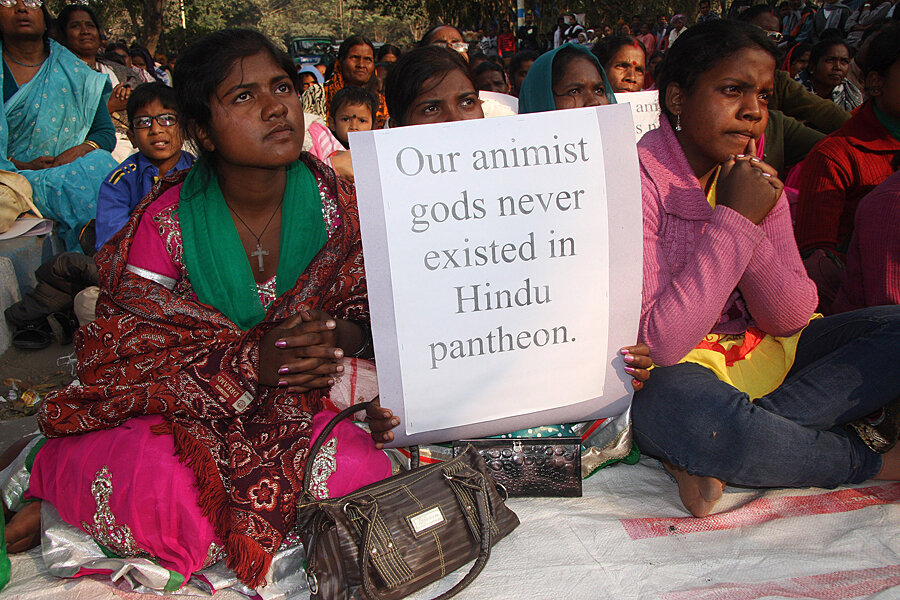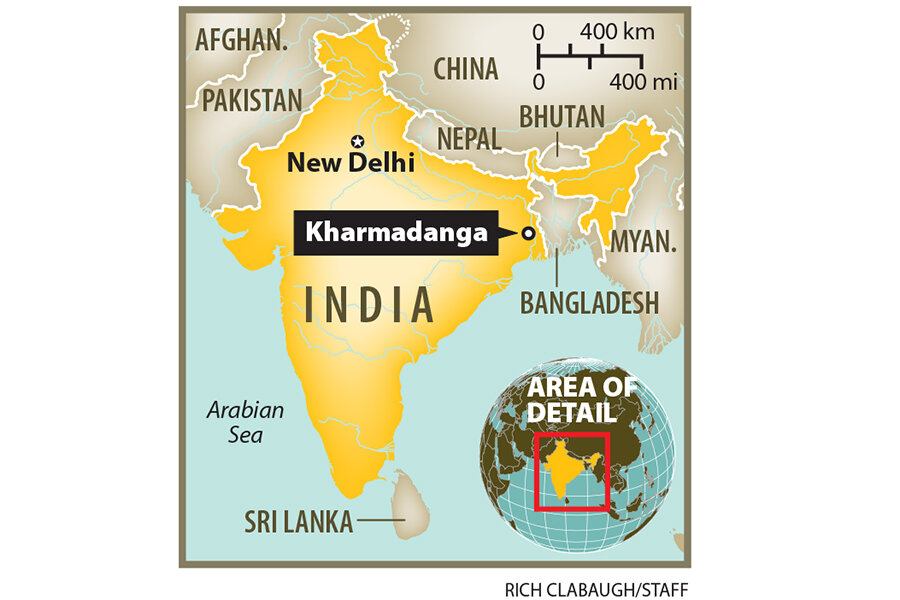Hindu homecoming? Case of India religious conversions looks bogus.
Loading...
| Kharmadanga, West Bengal, India
Standing in front of a new mud-walled Hindu temple in this Bengali village, Mangal Murmu stroked his chin and described an invitation to a Hindu feast in January for the temple's opening.
He enjoyed the feast, he says, and when he was handed flowers, he was happy to lay them on the altar – as did others who were asked to do so. It was a matter of respect.
The village of Kharmadanga is part of a “stone belt” region – providing rocks for construction across India – and is mostly made up of tribal Santhal people, who like Murmu are animist and worship a variety of gods. The village lies 140 miles north of Calcutta and is quite remote.
Yet last month, Kharmadanga made the national spotlight when Hindu groups claimed to convert 150 tribals here to Hinduism, including Mr. Murmu. Prestigious national newspapers reported that Christians and a handful of Muslims had accepted a new Hindu identity and faith in a special ceremony of fire.
In a society often riven with religious and ethnic tensions, conversions to different faiths, especially in high numbers, are a loaded subject. An estimated one-fifth of India's 1.27 billion people belong to faiths or sects other than Hinduism.
Conversions to Hinduism, called ghar wapsi or “homecoming,” are a main aim of the Hindu fundamentalist groups around Prime Minister Narendra Modi, known collectively as the Sangh Parivar. The groups want to see India become 100 percent Hindu, arguing this is its correct and natural state of affairs.
Studied silence?
Last spring, after Mr. Modi and his BJP party, a political wing of the Sangh Parivar, were elected, there was a great increase in homecomings and conversions. Whenever the issue is raised, Modi responds with a studied silence that some view as signaling tacit support.
Indeed, news of the 150 Kharmadanga conversions came on Jan. 28, one day after President Barack Obama ended a state visit to Delhi, where, among much bonhomie with Modi, the US president also sounded a note of concern about religious freedom for minority faiths in India.
“Every person has the right to practice his faith without any persecution, fear or discrimination,” Mr. Obama told a town hall meeting of youth in Delhi. “India will succeed so long as it is not splintered along the lines of religious faith.”
The very next day Hindu leaders announced that some 150 tribal Christians took part here in a conversion ritual of fire.
“They all took a pledge to follow a Hindu way of life,” said Sachindranath Singha, state secretary in West Bengal of the Vishva Hindu Parishad, the largest Hindu fundamentalist group and part of the Sangh Parivar.
The Indian Express reported that seven Muslims were converted at the ceremony as well.
Jugal Kishore, national secretary of the VHP, defended the conversions, telling reporters that, “We are not committing any sin by bringing back our people to our own religion. This is a service to our country and we will continue with the ghar wapsi.”
'I fell from the sky'
Yet back in Kharmadanga, Murmu is perplexed at all the attention. He says he and others did not convert to Hinduism, and that he is not Christian but a follower of the Saridharam animist belief. He just attended the temple feast, he says.
“Some Hindu religious people invited the surrounding villagers at the inauguration of the temple,” says Murmu, a day laborer. “I came here to take part in the feast. When the Babas asked me to [offer] flowers … I could not disobey what the fatherly men said.”
When Murmu's neighbors told him they read in the paper he had converted from Christianity to Hinduism, “I fell from the sky … all along my life I have been a follower of Saridharam.”
News of the purported mass conversion of tribals a day after Obama's speech caused a national stir. Several NGOs, along with the Monitor, traveled to the village and confirmed that no actual conversions took place, and that those named in India news reports were neither Christian nor Muslim.
Rather, the event and story appears to have been cooked up as propaganda and as a way to create momentum to force Hindu religious conversions elsewhere in the country.
Conversions appear bogus
“No Christian or Muslim converted to Hinduism at the Kharmadanga ceremony,” says Herod Mullick, president of the Bangiya Christiya Pariseba, a Calcutta-based umbrella Christian group, who led a team to the village. “The claim of ‘reconversion’ is just bogus… some key information related to the ceremony, as published in the media, is untrue.”
A different tribal NGO that sent a fact-finding team found that villagers named in national reports were not Christian but animist, though some said they had occasionally visited local churches, just as they had visited the opening ceremony of the Hindu temple.
They “had never been Christian at all,” said Subodh Hansda, deputy general secretary of the Adibasi Socio-Educational and Cultural Association in West Bengal. “They were not Hindu in the past.”
Mr. Mullick said the Sangh Parivar used faked conversions to motivate efforts elsewhere to convert Christians and Muslims.
Hindu nationalists argue that all persons from the subcontinent are once Hindus, and should return to the fold. Hindus were forcibly converted to Islam and Christianity after these faiths reached India, they contend. In December the international president of the VHP argued for India’s 84 percent Hindu population to become 100 percent Hindu.
Paving the way to a new life
Manmohan Vaidya of the elite right-wing Hindu group Rashtriya Swayamsevak Sangh (RSS) charges that churches are forcing Hindu tribals into changing their religion. (The RSS is also a branch of the Sangh Parivar.)
“Taking advantage of the weakness and ignorance of the tribes people, either fraudulently or using force or allurement, the churches have converted them for many decades or centuries," he says. "The tribal Christians have now come back to their senses …We are just paving their way to the new life. We are not using any force.”
John Dayal, former national president of the All India Catholic Union, calls the charge of forcible conversion by the church "ridiculous." He said the ruling Bharatiya Janata Party (BJP) sought "to put severe limitations on constitutional freedoms of faith, belief and conscience."
As for Christian missionaries, most work in areas with large Hindu populations. “How can they use force or fraud on anyone as members of the small minority community?” he says. “They would be lynched.”
So far, Indian Prime Minister Modi of the BJP has said nothing for or against the conversion program.
One prominent Indian Muslim leader, Imam Umer Ahmed Ilyasi, head of the All India Organization of Imams, faults Modi for this. “This is the nation of Mahatma Gandhi,” he said, “all religions are meant to be free here, but Modi has failed to address the fears of minorities.








